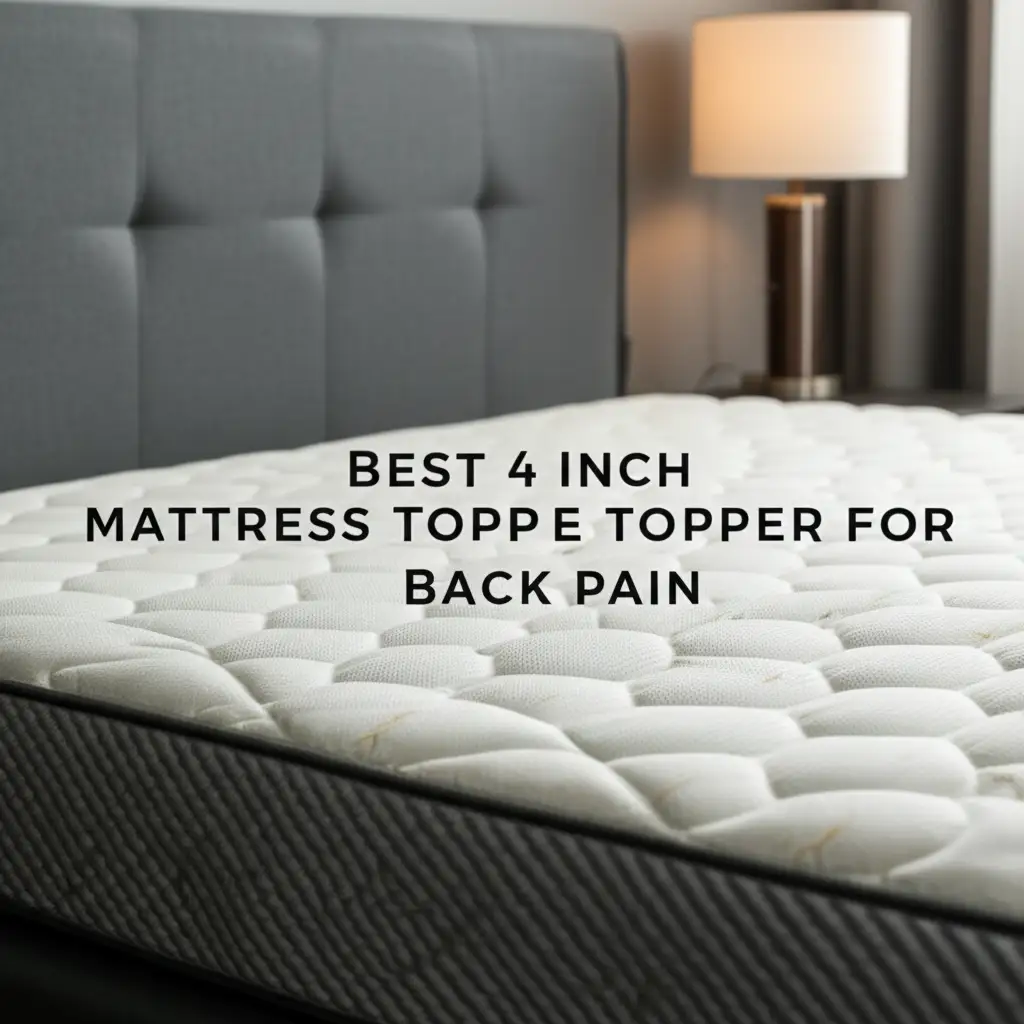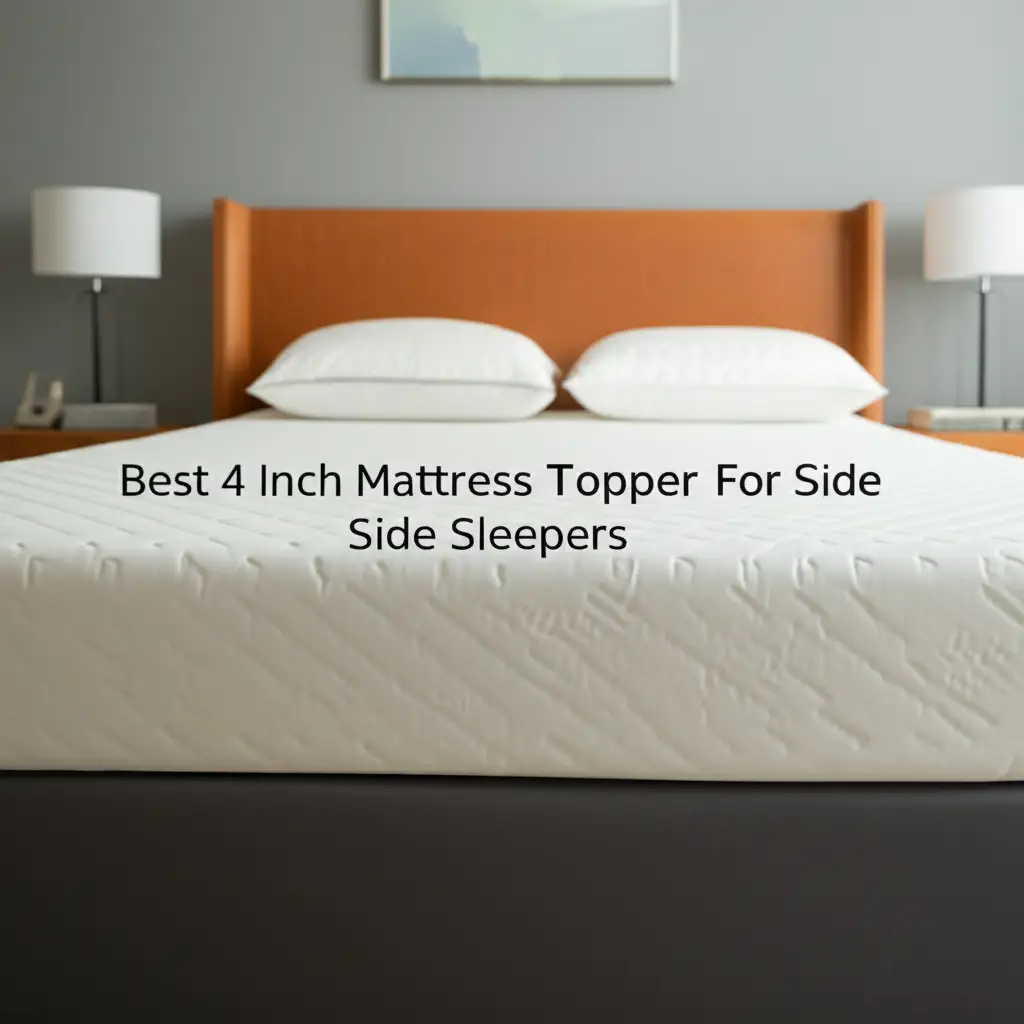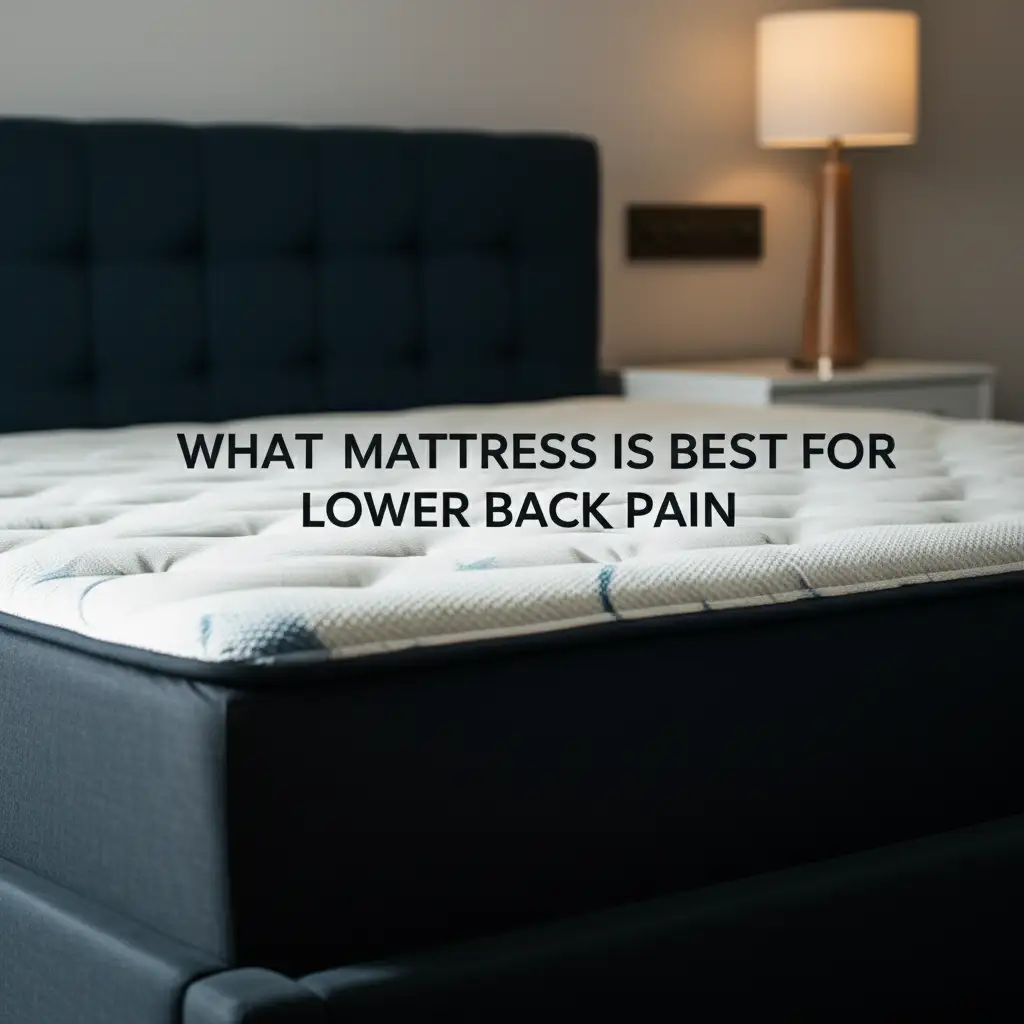· Mason Everett · Sleep Comfort, Back Pain Relief, Mattress Toppers · 19 min read
Best 4 Inch Mattress Topper For Back Pain

Finding Your Comfort: The Best 4 Inch Mattress Topper For Back Pain
Waking up with a stiff, aching back is a terrible start to any day. Your sleep surface plays a big role in your body’s comfort. If your current mattress feels too soft, too firm, or simply unsupportive, a significant upgrade might be necessary. I believe that finding the best 4 inch mattress topper for back pain can truly change your mornings. Many people ignore their mattress until pain becomes a constant companion.
A thick mattress topper offers a real solution. It provides an extra layer of comfort and crucial support. This depth helps to cushion pressure points while keeping your spine properly aligned. We will explore why a 4-inch topper is often the ideal choice. We will also look at the best materials and features to consider. By the end, you will understand how to choose a topper that offers real back pain relief and improved sleep quality.
Takeaway
- A 4-inch mattress topper offers substantial pressure relief and enhanced support for back pain.
- Memory foam and natural latex are top material choices due to their contouring and supportive properties.
- Prioritize a topper that promotes proper spinal alignment and alleviates pressure points.
- Consider features like density, firmness, breathability, and durability for lasting comfort.
The best 4 inch mattress topper for back pain provides significant pressure relief and robust support, aligning the spine. Memory foam and latex options excel here, offering a balance of contouring comfort and necessary firmness to alleviate discomfort effectively.
Why a 4-Inch Mattress Topper is Ideal for Back Pain Relief
Many people wonder if a mattress topper can truly help with back pain. The answer is a resounding yes, especially when it comes to a 4-inch model. This thickness provides a substantial layer between you and your existing mattress. It transforms the feel of your bed without needing to buy a new one. I think this depth is key for effective pain relief.
Thinner toppers, like 1 or 2 inches, offer some cushioning. However, they might not provide enough support to correct spinal alignment issues. A 4-inch topper creates a deep comfort zone. This zone allows your body to sink in just enough for pressure relief. At the same time, it maintains necessary underlying support. This balance is crucial for alleviating back discomfort.
The added material helps distribute body weight more evenly. This reduces pressure on sensitive areas like the lower back and hips. Proper weight distribution prevents your spine from curving unnaturally. It promotes a more neutral sleeping posture. This consistent support throughout the night allows muscles to relax. This can greatly reduce morning stiffness and pain. The difference between a 2-inch and a 4-inch topper is significant for serious back pain. A 4-inch topper is more likely to provide the deep, restorative support needed. It effectively cradles your body. This makes it a standout choice for those seeking relief. You can read more about how mattress quality impacts pain on our page about what mattress is best for lower back pain.
- Enhanced Cushioning: A 4-inch topper offers a plush surface. This surface cushions your body’s pressure points. It significantly reduces direct impact on hips and shoulders.
- Superior Support: This thickness provides enough material to truly support the natural curve of your spine. It fills in the lumbar region effectively.
- Weight Distribution: It helps spread your body weight evenly across the sleeping surface. This prevents specific areas from bearing too much pressure.
- Spinal Alignment: The generous depth works to keep your spine in a neutral position. This is vital for relieving pressure on discs and nerves.
- Conforming Comfort: It conforms closely to your body’s shape. This ensures consistent support tailored to your unique contours.
The decision to get a topper instead of a whole new mattress is often practical. It saves money. It also gives your current mattress a new life. This is especially true if your mattress is still relatively new but feels too firm. A good 4-inch topper can soften it just enough. It can also provide added support if your mattress has lost some of its firmness. I have seen many cases where a thick topper brought relief to sleepers. They thought their only option was a completely new bed. This deep layer also isolates motion well. If you share a bed, your partner’s movements will disturb you less. This leads to more restful, uninterrupted sleep. Understanding how important is a good mattress highlights why improving your sleep surface is key for overall health.
Top Materials for Back Pain: Memory Foam and Latex Toppers
When searching for the best 4 inch mattress topper for back pain, material choice is paramount. The two leading contenders are memory foam and latex. Each offers unique benefits for alleviating discomfort. I often recommend these two types for their excellent support properties. They stand out from other materials like wool or down.
Memory Foam Mattress Toppers
Memory foam is incredibly popular for a reason. It is known for its ability to conform precisely to your body shape. When you lie down, the foam softens with your body heat. It molds around your curves. This creates a custom cradle that supports every inch of your body. This contouring action distributes your weight evenly. It eliminates pressure points that can aggravate back pain. It fills the space around your lumbar region, providing targeted support. This keeps your spine in proper alignment. This pressure relief is a primary benefit for those with aching backs.
However, traditional memory foam can retain heat. This might be a concern for warm sleepers. Many modern memory foam toppers now incorporate cooling technologies. These include gel infusions, open-cell structures, or even graphite. For instance, understanding what is a graphite mattress topper can help you find a cooler option. The density of memory foam also matters. Higher density foam generally offers more support and durability. Lower density foam feels softer but might break down faster. When choosing, consider a medium-firm density for the best balance of comfort and support for back pain.
- Pros of Memory Foam:
- Excellent pressure point relief.
- Contouring support for spinal alignment.
- Motion isolation (good for couples).
- Available in various firmness levels.
- Cons of Memory Foam:
- Can trap heat (unless cooling features are added).
- May have an initial off-gassing smell.
- Can feel too soft for some heavier individuals.
Latex Mattress Toppers
Latex is another fantastic option for back pain sufferers. It offers a different feel compared to memory foam. Latex provides a buoyant, responsive support. It contours to your body but springs back quickly when you move. This makes it easier to change positions during the night. Natural latex comes from rubber trees. It is durable, hypoallergenic, and resistant to dust mites. Synthetic latex options also exist, often at a lower price point.
Latex provides excellent pressure relief similar to memory foam. However, it does so with a more generalized contour. It pushes back slightly, providing a floating sensation. This responsive support keeps your spine aligned without a deep hug. Many find latex sleeps cooler than traditional memory foam. Its open-cell structure allows for better airflow. For back pain, the consistent support of latex is very beneficial. It prevents sagging in key areas like the lower back. This constant support helps maintain a healthy spinal posture. This type of topper is particularly good for those who prefer a firmer, more resilient feel. For more detailed information on supportive sleep surfaces, you might check out articles like what mattress is best for lower back pain.
- Pros of Latex:
- Responsive and buoyant feel.
- Excellent durability and longevity.
- Naturally hypoallergenic and dust mite resistant.
- Better airflow for cooler sleep.
- Consistent, even support.
- Cons of Latex:
- Generally more expensive than memory foam.
- Can be heavy and difficult to move.
- Distinctive smell, though less chemical than memory foam.
Both memory foam and latex can significantly improve sleep for those with back pain. The choice often comes down to personal preference for feel. Do you prefer a deep hug (memory foam) or a buoyant, responsive lift (latex)? A 4-inch thickness in either material provides enough support and comfort to make a real difference.
Key Features to Look for in a 4-Inch Topper for Spinal Support
Choosing the best 4 inch mattress topper for back pain involves more than just material selection. Several key features contribute to effective spinal support and overall comfort. Ignoring these details can lead to disappointment, even with a great material. I always advise people to look beyond just the type of foam or latex.
Firmness Level
The right firmness is crucial for back pain relief. For most back pain sufferers, a medium-firm feel is ideal. This firmness provides enough support to keep your spine aligned. It also offers enough cushion to alleviate pressure points. A topper that is too soft will allow your body to sink too much. This can lead to improper spinal alignment and increased pain. A topper that is too firm might not offer enough pressure relief. It can feel like sleeping on a board. This can create new pressure points. Finding that sweet spot, often described as a supportive yet conforming feel, is key. This balance prevents your spine from curving unnaturally, whether you sleep on your side or back.
Density and ILD (Indentation Load Deflection)
Density refers to how much material is packed into the foam. For memory foam, a density of 4-5 lbs/cu.ft. is generally good for support and durability. Higher density often means better quality and a longer lifespan. It also means more robust support. For latex, ILD (Indentation Load Deflection) measures firmness. A lower ILD means softer latex, while a higher ILD means firmer latex. For back pain, an ILD in the medium range (around 25-35) is often recommended. This balance provides both contouring and support. These metrics help you understand how supportive and durable the topper will be over time. They directly impact how well the topper maintains its shape and support for your spine.
Pressure Point Relief
This is paramount for back pain. A good 4-inch topper should cradle your body. It must reduce pressure on your hips, shoulders, and lower back. When you lie down, your body should feel evenly supported. There should be no specific areas feeling excessive pressure. Materials like memory foam excel at this by distributing weight broadly. Latex offers consistent support that prevents “hot spots” of pressure. Effective pressure relief helps blood circulation. It also allows muscles to relax. This promotes healing and reduces soreness. A mattress that doesn’t provide this can even cause neck pain. You can learn more about this problem on our page about can mattress cause neck pain.
Cooling Features
Overheating during sleep can lead to tossing and turning. This disrupts restorative sleep. It also worsens back pain. Look for toppers with cooling technologies. These include:
- Gel infusions: Tiny gel beads absorb and disperse heat.
- Open-cell structures: These foams have larger pores for better airflow.
- Graphite or copper infusions: These materials draw heat away from the body.
- Perforated designs: Holes in the foam improve ventilation.
Latex is naturally more breathable than traditional memory foam. If you are a warm sleeper, prioritizing cooling features is essential. A cooler sleep environment helps your body stay relaxed. This prevents muscle tension that can aggravate back pain.
Motion Isolation
If you share your bed, motion isolation is important. A good topper will absorb movement. This means you will not feel your partner shifting during the night. Memory foam is excellent at this. Latex also offers good motion isolation, though slightly less than memory foam. Undisturbed sleep is vital for recovery and pain management. It allows your body to enter deeper sleep cycles. This promotes muscle repair and reduces inflammation. A luxury mattress pad or topper also often includes these features. You can explore options at what is a luxury mattress pad.
Choosing the Right Firmness: Balancing Comfort and Support
Selecting the correct firmness for your 4-inch mattress topper is a critical step in addressing back pain. It is a balance. You need enough softness for comfort. You also need enough firmness for robust spinal support. I have seen many people pick a topper that is either too soft or too firm. This often leads to continued discomfort.
Understanding Firmness for Back Pain
For most individuals with back pain, a medium-firm topper is often the sweet spot. This level of firmness allows your body to sink in slightly. It cradles your curves. This provides excellent pressure relief for areas like your shoulders and hips. At the same time, it maintains a level surface. This prevents your spine from sagging or arching excessively. An overly soft topper might feel luxurious initially. However, your body could sink too much. This causes your spine to fall out of alignment. This misalignment can exacerbate lower back pain. Conversely, a topper that is too firm might not offer enough cushioning. It can create new pressure points. This leaves your back feeling rigid and unsupported.
Consider your primary sleeping position as well.
- Back Sleepers: Generally benefit from a medium-firm topper. It supports the natural “S” curve of the spine. It keeps the head, shoulders, and hips aligned.
- Side Sleepers: Need a topper that allows their hips and shoulders to sink in slightly. This keeps the spine straight. A medium-firm or even a slightly softer topper might work well. However, remember the 4-inch depth provides ample cushioning. A 2-inch topper, for example, would offer less cushioning for side sleepers. You can find more specific advice for side sleepers at best 2 inch mattress topper for side sleepers.
- Stomach Sleepers: This position is generally not recommended for back pain. If you must sleep on your stomach, a firmer topper is essential. It prevents your hips from sinking too deeply. This keeps your spine from arching.
Factors Influencing Your Firmness Choice
Your body weight also influences the ideal firmness.
- Lighter Individuals: May find a slightly softer medium-firm topper more comfortable. They do not exert as much pressure on the surface.
- Heavier Individuals: Often require a firmer medium-firm topper. This provides adequate support to prevent excessive sinking. It ensures proper spinal alignment.
The condition of your existing mattress also plays a role. If your current mattress is very firm, a medium-soft to medium-firm 4-inch topper can add necessary plushness. If your mattress is old and sagging, a topper might not fix the underlying issue. It might be time to consider a new mattress. You can explore what mattress is best for lower back pain for more insights on mattress choices. Ultimately, the goal is to create a sleep surface that keeps your spine in a neutral, relaxed position throughout the night. This allows your muscles to truly relax and recover.
Understanding Different Types of Back Pain and Topper Suitability
Back pain is a broad term. It encompasses various conditions and discomforts. The type of back pain you experience can influence the kind of 4-inch mattress topper that will offer the most relief. I think understanding your specific pain is important for making the right choice. No single topper works for everyone.
Lower Back Pain (Lumbar Pain)
This is the most common type of back pain. It often results from poor posture, muscle strain, or disc issues. For lower back pain, consistent support for the lumbar region is crucial. A 4-inch memory foam or latex topper with a medium-firm feel is often ideal.
- Memory Foam: Its deep contouring capability fills the curve of your lower back. This provides personalized support. It reduces pressure on the lumbar spine.
- Latex: Offers a more buoyant, responsive support. It keeps the lower back lifted without allowing it to sink too deeply. This maintains natural spinal alignment. Both materials prevent the lower back from sagging. Sagging puts strain on the spinal discs and muscles. This type of topper allows the lumbar muscles to relax. This can lead to significant pain reduction.
Upper Back and Neck Pain
Upper back pain often stems from muscle tension or poor posture, often linked to desk work or phone use. While a mattress topper primarily affects the body from the shoulders down, improving overall spinal alignment can indirectly help the upper back and neck.
- A 4-inch topper that provides excellent spinal alignment overall helps. If your lower body is properly supported, your upper body can rest more naturally.
- Ensuring the topper is not too soft is important. If the topper is too soft, your shoulders might sink too much. This can push your neck into an awkward position.
- A quality pillow is also crucial for neck pain. However, a good topper sets the foundation for proper alignment. You can find more information about how your sleep surface affects pain at can mattress cause neck pain.
Sciatica
Sciatica involves pain radiating along the sciatic nerve. This nerve runs from your lower back down one or both legs. It is often caused by compression of the nerve. For sciatica, pressure relief is paramount.
- Memory Foam: The deep contouring of a 4-inch memory foam topper excels at relieving pressure points. It distributes body weight evenly. This can reduce direct pressure on the sciatic nerve.
- Latex: Offers resilient support that helps keep the spine aligned without excessive sinking. This can prevent nerve impingement. The goal is to reduce any compression on the nerve. A topper that conforms without creating new pressure points is best. It should also provide consistent support to keep the spine neutral. This helps prevent twisting or bending that can irritate the nerve.
General Back Stiffness and Aches
Many people experience general morning stiffness or aches without a specific diagnosis. This often results from an unsupportive mattress.
- A 4-inch topper can revitalize an aging mattress. It adds a fresh layer of comfort and support.
- It improves overall sleep posture. This allows muscles and joints to relax during the night.
- Both memory foam and latex can be highly effective. The choice depends on personal preference for feel. Regardless of the specific type of back pain, the consistent theme is the need for proper spinal alignment and effective pressure relief. A 4-inch topper, with its generous depth, is well-equipped to deliver both. It offers a substantial upgrade to your sleep surface. This transforms an uncomfortable bed into a supportive haven. To truly resolve the pain, sometimes a new mattress is necessary. Our guide on what mattress is best for lower back pain offers further insights on full mattress choices.
Installation and Maintenance for Longevity and Hygiene
Once you have chosen the best 4 inch mattress topper for back pain, proper installation and ongoing maintenance are key. These steps ensure your topper performs optimally. They also extend its lifespan and maintain a hygienic sleep environment. I know many people overlook these simple steps. However, they make a big difference in long-term satisfaction.
Initial Setup and Expansion
Most 4-inch mattress toppers, especially memory foam, arrive compressed and rolled in a box.
- Unpack Carefully: Remove the topper from its packaging. Be gentle to avoid damaging the material.
- Allow to Expand: Unroll the topper on a flat, clean surface, ideally on your mattress. Memory foam toppers need time to fully expand. This can take anywhere from a few hours to 48-72 hours. The full 4 inches of thickness and optimal firmness will emerge during this period. Ensure the room is well-ventilated during this time. This helps dissipate any “new foam” smell (off-gassing).
- Position Correctly: Once fully expanded, center the topper on your mattress. Many toppers come with elastic straps or a non-slip bottom. These features help secure it in place. This prevents shifting during the night.
- Add a Mattress Protector: I highly recommend covering your new topper with a high-quality mattress protector. This shield protects it from spills, dust mites, and allergens. It is much easier to wash a protector than to clean the topper itself.
Regular Care and Maintenance
Proper care extends the life of your topper and keeps it fresh.
- Spot Clean Spills Immediately: For liquid spills, blot gently with a clean cloth. Use a mild soap and water solution if necessary. Avoid saturating the foam. Let it air dry completely before replacing bedding.
- Vacuum Regularly: Lightly vacuum the topper surface every few months. Use a brush attachment to remove dust and debris. This is part of a routine mattress cleaning process. For deeper cleaning insights, you can check how to deep clean your mattress.
- Rotate Periodically: Rotate your topper 180 degrees every 3-6 months. This helps distribute wear evenly. It prevents permanent indentations from forming in one spot. This is similar to how you would rotate a mattress itself.
- Air Out: If possible, periodically remove all bedding. Allow the topper to air out for a few hours. This helps dissipate moisture and keeps it fresh.
- Avoid Direct Sunlight: Do not expose foam toppers to direct sunlight for prolonged periods. UV rays can degrade the material over time.
Cleaning the Topper
While spot cleaning is often sufficient, a deeper clean may sometimes be necessary.
- Memory Foam: Never machine wash or tumble dry memory foam. It will damage the material. For a more thorough clean, sprinkle baking soda over the topper. Let it sit for several hours to absorb odors. Then vacuum it up. You can also lightly mist it with a diluted fabric refresher. Ensure it is completely dry before putting sheets back on. More tips on general mattress care can be found at do it yourself mattress cleaning.
- Latex: Latex is naturally more resistant to mold and dust mites. It also should not be machine washed. Spot clean spills as with memory foam. Airing it out regularly helps keep it fresh.
Following these maintenance tips helps your 4-inch mattress topper retain its supportive properties. This ensures it continues to provide the back pain relief you need for years to come. A clean and well-maintained sleep surface also contributes to overall better sleep hygiene.
When to Upgrade Your Entire Mattress vs. Just a Topper
A 4-inch mattress topper for back pain can work wonders. It breathes new life into an old bed. It provides much-needed support and comfort. However, a topper is not always the ultimate solution. Sometimes, your mattress has simply reached the end of its life. Knowing when to upgrade your entire mattress versus just adding a topper is important. I often see people delaying a full mattress replacement. This can prolong their discomfort.
When a Topper is a Good Solution
A 4-inch topper is an excellent choice in several scenarios:
- Your mattress is too firm: If your current mattress provides good support but feels too hard, a 4-inch memory foam or latex topper can add softness and pressure relief. It makes the surface more forgiving.
- Your mattress is slightly too soft: A dense, supportive 4-inch topper can add firmness and prevent excessive sinking. This is particularly true if your mattress is relatively new but just lacks sufficient core support for your body type.
- Minor sagging or wear: If your mattress has minor indentations





